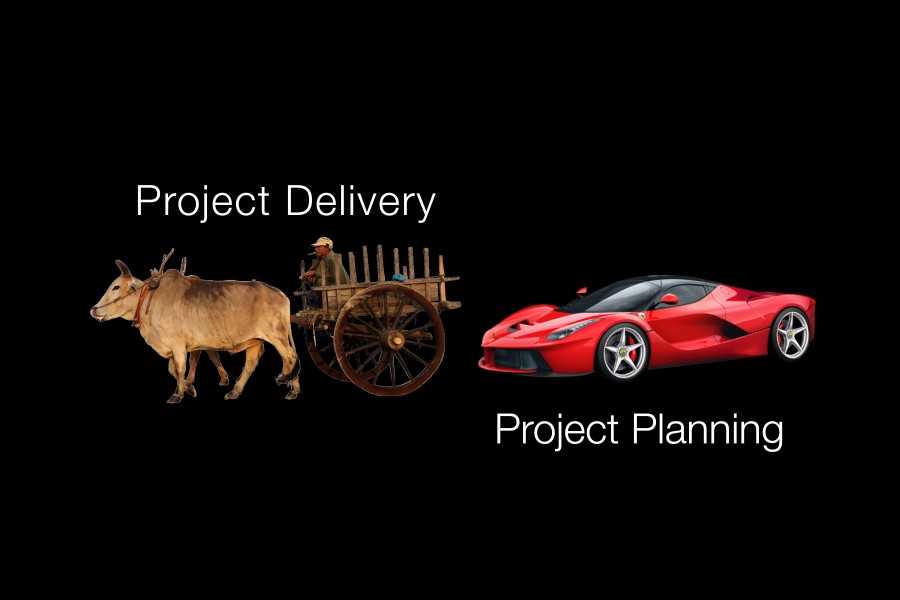The Subtle Art of Not Screwing Projects

Sitting around the meeting table, all 13 serious faces looked in the same direction where the tragedy was unfolding. On the screen was displayed the “latest”(version no. 6) of the project schedule. Attended by the top echelons of the project team with a cumulative experience of over 150 years, this was a high-level weekly meeting to discuss the status of a pharmaceutical facility project, a moderately-sized undertaking.
Even though it was a Friday, the atmosphere was tense. Had to be! Our project had skidded off the schedule—yet again! What the horizontal bars (I mean Primavera schedule) on the screen projected and the bitter reality were not even close. Basically, the most dreaded D-word in any project—Delay–was in the air with all its unbearable stench.
Clearing his throat out of sheer impatience, the client’s top man remarked, “This delay is absolutely not acceptable. We want the site to be handed over within the next eight months. Please rework this schedule and let us know by Monday how to make it happen.” Clear and curt message!
So this was a meeting not just about the ugly gap between the schedule and the actual progress but also about further squeezing the damn schedule and then—somehow–hastening up the execution to achieve the milestones. Some people around the table knew (both in their minds and hearts)…we were in a fantasy land; considering the actual status of the project, the projected milestones were like demanding a baby be born in six months, not the usual nine. But who could admit it?
Acknowledging the delay, the main contractor’s planner, an unusually composed person, nodded with total sincerity, promising to come up with an even tighter schedule “soon.” There was a sigh of relief in the room, and with lunchtime approaching, the meeting was adjourned with a usual conclusion…to meet again.
This was not the first meeting of its kind in this project or other projects I have done. Such meetings happen regularly in most projects with the same set pattern: Disappointment and frustration over the delay, pinning the blame, storytelling to defend the delay, pushing and pulling, and finally, a promise to do better. This meeting cycle continues while outside on the project site—the real world–reality continues to bite the project, one bite at a time.
Projects are complex undertakings involving multiple systems that need to work seamlessly, many vendors and contractors, and of course, several constraints and risks. But should the projects go off-track almost by default? Can the tug of war between the clients and contractors be avoided? Can we avoid the usual high-blood pressure experience of managing projects—along with the ugly blame game?
Basically, what does it take to execute a successful project, a project delivered on time, on budget and as per the requirements–minus the usual drama?
How Big Things Get Done?
The quest to find answers led me to the just-published book “How Big Things Get Done – The Surprising Factors Behind Every Successful Project, from Home Renovations to Space Exploration,” written by Bent Flyvbjerg and Dan Gardner. So who is Bent Flyvbjerg, the lead author?

Besides being a professor at Oxford University and IT University of Copenhagen, he is a practitioner of the art and science of project management. He not only advises firms and governments worldwide on mega projects but also directly manages projects himself.
The book covers insights from a study of more than 16,000 projects, ranging from the Empire State Building, Hoover Dam and Sydney Opera House to the Pentagon building, Guggenheim Museum Bilbao, Spain, Heathrow T5 terminal and Hong Kong high-speed railway line. And even IT projects.
So, what’s the track record of projects in general? According to Flyvbjerg, the answer is depressing: “In total, only 8.5 per cent of projects hit the mark on both cost and time.”
Why do a whopping 91.5% of projects fail to deliver on time or cost or both?
Like a jigsaw puzzle, he offers several pieces of advice that should come together to ensure success in a project, such as “Start with a clear purpose (why) or hire the right partners and people or don’t think lowest bidding means the lowest cost or mitigate risks before they hit the project. But of all pieces, the most counterintuitive is: If you really want to execute a project fast, think slowly. What does it mean?
Think slow, act fast
To understand the “Think slow, act fast” insight, first, we need to see a project, regardless of its complexity and magnitude, comprising two parts: planning and delivery (or execution).
The typical way is to rush the planning phase and get into execution because unless shovels are put into the ground or some structures are built on-site, people don’t feel the project is moving forward. Planning is considered intangible (drawings, coordination, modelling, reports, schedules, estimates, risk mitigation, etc.), something to be quickly done so that the “real” action on site can begin.
Once it gets to execution, the usual way is to press hard, demand faster and faster progress, fight the fires as they erupt and simply be fierce or even ruthless.
Says Flyvbjerg, “This thinking is as misguided as it is common. Haste makes waste, sometimes even tragedy.” He cites several examples where rushing the planning phase resulted not in faster completion but a mess.
According to Flyvbjerg, projects don’t go wrong, they start wrong. In a way, projects are no different from the shot of a golf ball: You hit the ball just a few millimetres off the right trajectory—and you’ll end up a few hundred of meters away from the target later. The gap grows exponentially.
Hard to imagine, but sadly, that’s what happened to the iconic Sydney Opera House project.
Sydney Opera House – A tragedy befitting an opera
What would you call a project that took 14 years instead of the original five and was 1,400 per cent over the estimated cost? A disaster! That’s the irony behind that iconic building, considered by UNESCO an indisputable masterpiece of human creativity.

So what happened?
The project started like any other prestigious project–with a design competition. The next step, however, proved to be a double-edged sword. The Danish architect John Utzon won the competition with a proposal that mesmerised the selection committee; his concept included those sea shells like curved roofs that is the very uniqueness of the Sydney Opera House as we know it today.
But at this stage, neither Utzon had done his homework on constructing those curved roofs nor anyone asked him to submit a detailed design and construction feasibility. He had won the competition based on some brilliant but preliminary sketches.
Under political pressure to move forward, the project started without a proper design and planning, and sure enough, it hit roadblocks, running deeper and deeper into delays and cost overruns. The magnitude of the mess was such that even the completed work had to be demolished using dynamite and restarted again.
Seven years after the project began, Utzon was pushed out of the project. When 14 years later, the building opened in Oct 1973, it was acoustically unsuitable for opera and had major defects.
Was Sydney Opera house a curious exception? Unfortunately, not! Even the symbol of American power, the Pentagon, had a rushed start.
The Pentagon – Rushed start but saved
In 1941, at the cusp of World War II, the US government decided to construct a building large enough to be the US defence headquarters. Leading the project was Brigadier General Brehon B. Somervell, the chief of the army’s Construction Division, a man known for super-aggressive project management.

True to his form, he gave his team a marching order to draw plans for an office building as large as 500,000 square feet over…the next 4 days. While working over the weekend, the team realised that Somervell’s originally proposed site for the building was a marshy floodplain, so they changed it to an alternative site nearby. Exactly four days later, on Monday morning, the proposal was on Somervell’s table. Not wasting any more time, Somervell immediately rushed and got approvals from the Secretary of War, the Congressional sub-committee and President Roosevelt—all within a week. Think about it: A building to house the complete US defence establishment got conceptualised in 4 days and approved within a week.
When the plans became public, it turned out that even the alternative site chosen was not suitable and also the proposed building itself was misshapen. After a public outcry, the plans had to be scrapped, and a better site was selected where the world-famous Pentagon stands today.
Why such a rush would happen at the highest levels of the US government, and that too for such an important building?
Rush to commit
According to Bent Flyvbjerg, the answer lies in what he calls the “rush to commit” or “commitment fallacy.” More specifically, “It is fundamentally typical of how big projects come together. Purposes and goals are not carefully understood. Alternatives are not explored. Difficulties and risks are not investigated. Solutions are not found. Instead, shallow analysis is followed by a quick lock-in to a decision that sweeps aside all the other forms the project could take.”
Similar false starts were the cause of major problems in mega projects like:
- California high-speed rail: Started in 2008 but still incomplete with an estimated cost overrun of more than 3 times and scope dramatically reduced.
- Great Belt project (bridges and undersea tunnel) in Denmark: Involved a major accident, huge delay and cost overrun of about 55%.
- Hong Kong high-speed rail line: Started in 2011, but by the target date (2015), it was less than half complete with more than half the budget consumed. As this stage, Flyvbjerg was engaged to get the project on track.
Are there any exceptions to “Rush to commit” and “Think fast, act slow” trajectories of projects? Yes, indeed. Successful projects like the famous Empire State Building, Guggenheim Museum Bilbao, Spain, and Heathrow T5 Terminal are examples of careful planning followed by no-drama execution to end up on time and within budget.
Stepping back
If you’ve come this far in this long article, it’s time to reflect on whether Bent Flyvbjerg’s counterintuitive insight “think slow…so you can act fast” makes sense.
Regardless of the project you’re doing or have done in the past (construction or IT or something else), do you think the problems that consume most of the executive time and energy in projects can be minimised if projects start with:
- a clear understanding of the purpose (goal);
- precise user requirements, minimising the issues related to scope creep and design changes (especially during execution);
- robust concept and detailed design and feasibility that is properly reviewed and revised until it gets right;
- detailed and practical tender/bid documents;
- good, reliable coordination among different services to avoid clashes;
- a schedule that is baked well with all the relevant tasks, realistic durations and correct sequences; and
- careful identification of key risks and mitigation measures.
As for the project for which I attended the meeting, we could honestly answer “Not done or not done properly” for all the above items. Ours was a case of “think fast, act slow.” No wonder we were paying the price with confusion, frustration, fire-fighting, delays and sheer helplessness.
If I only had an hour to chop down a tree, I would spend the first 45 minutes sharpening my axe.
– Abraham Lincoln
